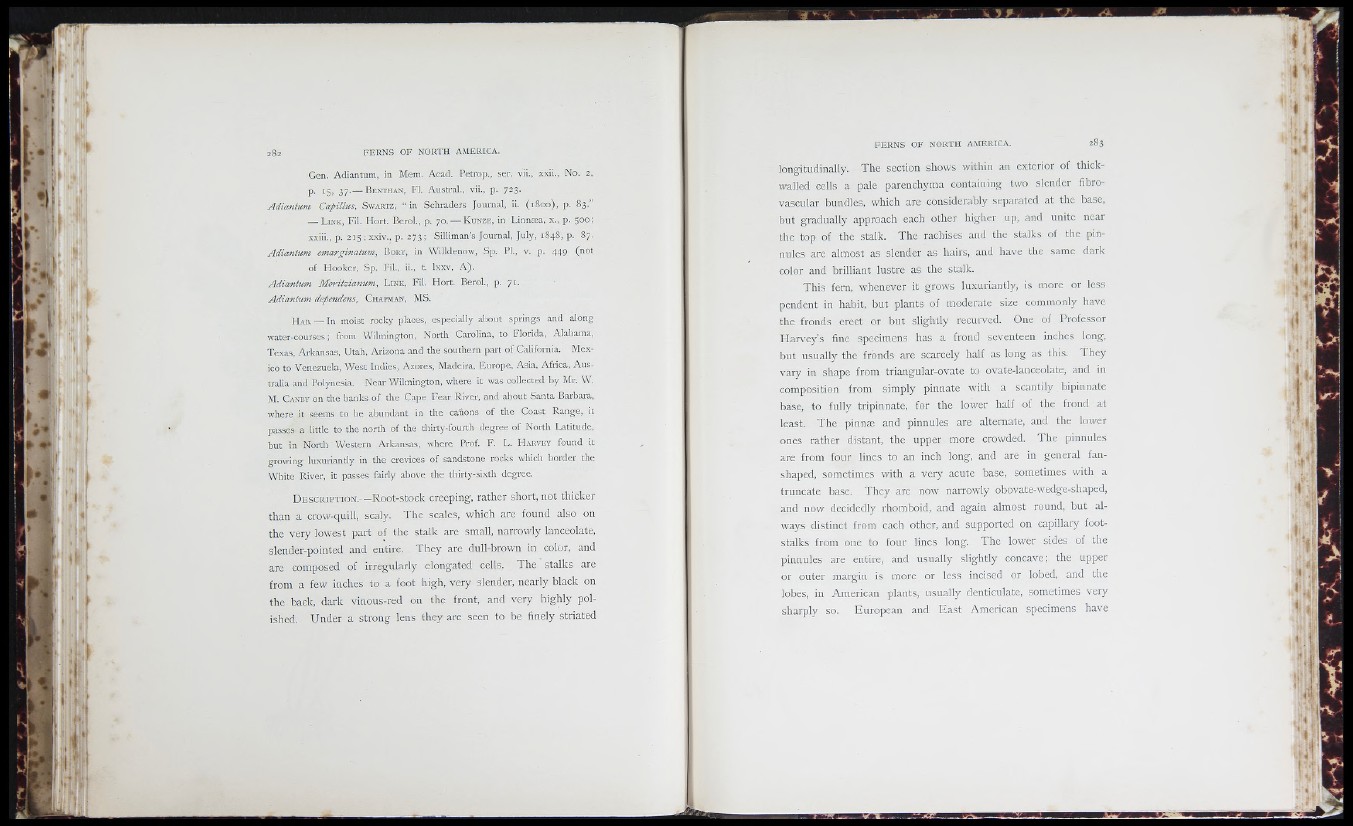
•>j
I»
w
M
N
U
r
II» «•
[ù «1,
i
|> i l
iri ' 1 T ±
h
i T
Gen. Adiantum, in Mem. Acad. Petrop., set. vii., xxii.. No. 2,
P- 15. 37-— B e n t h a n , Fl. Austral, vii., p. 723.
Adiantum Capilhcs, S w a r t z , “ in Schraders Journal, ii. (1800), p. 83.”
— L in k , F i l Hort. Berol, p. 70.-— K u n z e , in Linnæa, x., p. 500:
xxiii., p. 2 15 ; xxiv., p. 273 ; Silliman’s Journal, July, 1848, p. 87.
Adiantum emarginatum, B o r y , in Willdenow, Sp. Pl., v. p. 449 (not
of Hooker, Sp. F il, ii., t. Ixxv, A ).
Adiantum Moritzianum, L in k , F il Hort. Berol, p. 71.
Adiantum dependens, C h a p m a n , MS.
H a b . — In moist rocky places, especially about springs and along
water-courses ; from Wilmington, North Carolina, to Florida, Alabama,
Texas, Arkansas, Utah, Arizona and the southern part of California. Mexico
to Venezuela, West Indies, Azores, Madeira, Fiirope, Asia, Africa, Australia
and Polynesia. Near Wilmington, where it was collected by Mr. W.
M. C a n b y on the banks of the Cape Fear River, and about Santa Barbara,
where it seems to be abundant in the canons of the Coast Range, it
passes a little to the north of the thirty-fourth degree of North Latitude,
but in North Western Arkansas, where Prof. F. L. H a r v e y found it
growing luxuriantly in the crevices of sandstone rocks which border the
White River, it passes fairly above the thirty-sixth degree.
D e s c r i p t io n . -Root-stock creeping, rather short, not thicker
than a crow-quill, scaly. The scales, which are found also on
the very lowest part of the stalk are small, narrowly lanceolate,
slender-pointed and entire. They are dull-brown in color, and
are composed of irregularly elongated cells. The stalks are
from a few inches to a foot high, very slender, nearly black on
the back, dark vinous-red on the front, and very highly polished.
Under a strong lens they are seen to be finely striated
longitudinally. The section shows within an exterior of thick-
walled cells a pale parenchyma containing two slender fibro-
vascular bundles, which are considerably separated at the base,
but gradually approach each other higher up, and unite near
the top of the stalk. The rachises and the stalks of the pinnules
are almost as slender as hairs, and have the same dark
color and brilliant lustre as the stalk.
This fern, whenever it grows luxuriantly, is more or less
pendent in habit, but plants of moderate size commonly have
the fronds erect or but slightly recurved. One of Professor
Harvey’s fine specimens has a frond seventeen inches long,
but usually the fronds are scarcely half as long as this. They
vary in shape from triangular-ovate to ovate-lanceolate, and in
composition from simply pinnate with a scantily bipinnate
base, to fully tripinnate, for the lower half of the frond at
least. The pinnæ and pinnules are alternate, and the lower
ones rather distant, the upper more crowded. The pinnules
are from four lines to an inch long, and are in general fanshaped,
sometimes with a very acute base, sometimes with a
truncate base. They are now narrowly obovate-wedge-shaped,
and now decidedly rhomboid, and again almost round, but always
distinct from each other, and supported on capillary footstalks
from one to four lines long. The lower sides of the
pinnules are entire, and usually slightly concave; the upper
or outer margin is more or less incised or lobed, and the
lobes, in American plants, usually denticulate, sometimes very
sharply so. European and East American specimens have
M .